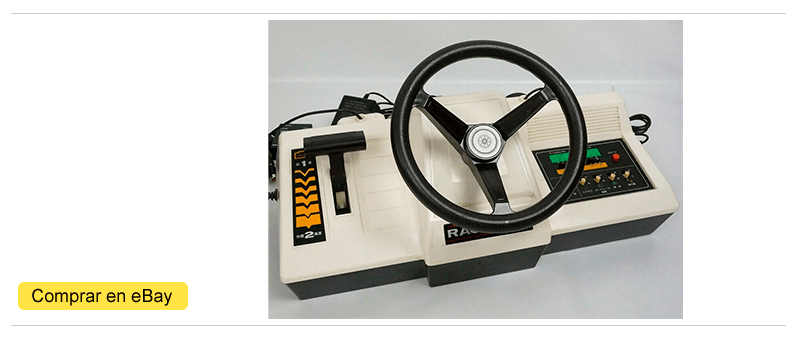Nintendo Color TV-Game Racing 112, Nintendo’s retro console with a steering wheel and 112 video games… Who gives more!? Launched in 1978, the CTG-CR 112 model was Nintendo’s third home console, framed in the Color TV-Game console series, it was an interesting bet that brought all the excitement of car racing to Japanese homes.
With this dedicated video game console (without cartridges), Nintendo offered the Japanese public already tired of pong, 112 racing games at home with its own steering wheel, gear shifter and two controls for stuntmen for 18,000 yen… interesting right? Let’s remember Color TV-Game Racing 112, one of Nintendo’s great unknowns.
| COMPANY: | Nintendo |
| CONSOLE GENERATION: | 1ST GENERATION OF CONSOLES |
| RELEASE DATE: | June 24, 1978, Japan |
| GAMES CATALOG: | 112 variants. |
| SOLD UNITS: | 160,000 units |
| LAUNCH PRICE: | 18.000 yen |
| PROCESSOR: | Nintendo/Mitsubishi Electric LSI (no CPU) |
| FORMAT: | Integrated games |
| BUY IT ON EBAY: | https://ebay.us/fiU61y |
- History of Color TV-Game Racing 112.
- The 112 video games of the Color TV-Game Racing 112.
- Price of a Color TV-Game Racing 112 console. How much did it cost?
- Collect the original Nintendo Color TV-Game Racing 112.
- Comprar una Color TV-Game Racing 112.
- TOP Retro: Best games of the Color TV-Game Racing 112.
- FAQ Color TV-Game Racing 112.
La Nintendo Color TV-Game Racing 112 es la tercera consola de Nintendo, si os interesa la historia de las primeras consolas de Nintendo os invito a que antes de continuar leáis el artículo dedicado a las dos primeras consolas de Nintendo: The Color TV-Game 6 / Color TV-Game 15.
Nintendo Color TV-Game Racing 112, the third Nintendo console
The 70’s were frenetic years in the history of videogames, month after month progress was made both in technology and in creativity and concepts, creating new machines, new videogames and consequently, new genres. Except for the glorious arrival of the Magnavox Odyssey in the domestic market in 1972, it was the arcade machines that set the pace in the new video game market since the arrival of the Atari Pong in 1972.
It was in the arcades where the engineers poured all their creativity and the companies allocated their main resources, having the possibility of improving the hardware with each new video game, these were years in which the video game defined the hardware. But little by little, starting in 1974 and mainly 1975, the domestic console market began to emerge with Pong versions of its older sisters. They were simple clone games on first generation video game consoles, but a new market had come to stay, video games conquered our homes with the blow of “ping-pong”.
Nintendo, originally a card company founded in 1889, in the 70’s was diversifying its market (electronic toys, arcade…), so it decided to enter the home console market with its Pong-type consoles, the Color TV-Game 6 and Color TV-Game 15 launched in 1977. Actually, both systems were the same console, which used Mitsubishi Electric Corporation (LSI) technology and incorporated color as a great novelty.
And they did well. Nintendo sold more than 1.4 million Color TV-Game 6 and 15 consoles, its engineers were motivated and decided to take a step forward with a much more innovative and differentiated product from the competition (Pong clones). In 1978 there were three genres that were most successful in arcades:
- The shooting games.
- The racing games.
- The sports games.
Nintendo engineers were excited after bringing Pong-style sports games to Japanese homes, so now they fantasized about converting all the arcade hits to dedicated consoles thanks to LSI (Large Scale Integration) technology. As with the first two Color TV-Game consoles, Nintendo engineers worked closely with Mitsubishi Electric Corporation to design and manufacture the LSI. The result would be something never seen in Japan, a console that theoretically brought the excitement of car racing to homes with an incredible 112 different games inside.
How is the Nintendo Color TV-Game Racing 112?
As we have already mentioned, the Nintendo Color TV-Game Racing 112 is a first generation dedicated console with 112 games inside. The console is large, simulating a car cabin in addition to its steering wheel and two-speed lever, it has two controls with enough wiring to reach the sofa of any average house. The controls, as was usual in those years, are welded to the console itself, so they cannot be removed. Consequently, it has two spaces to store them in the back.
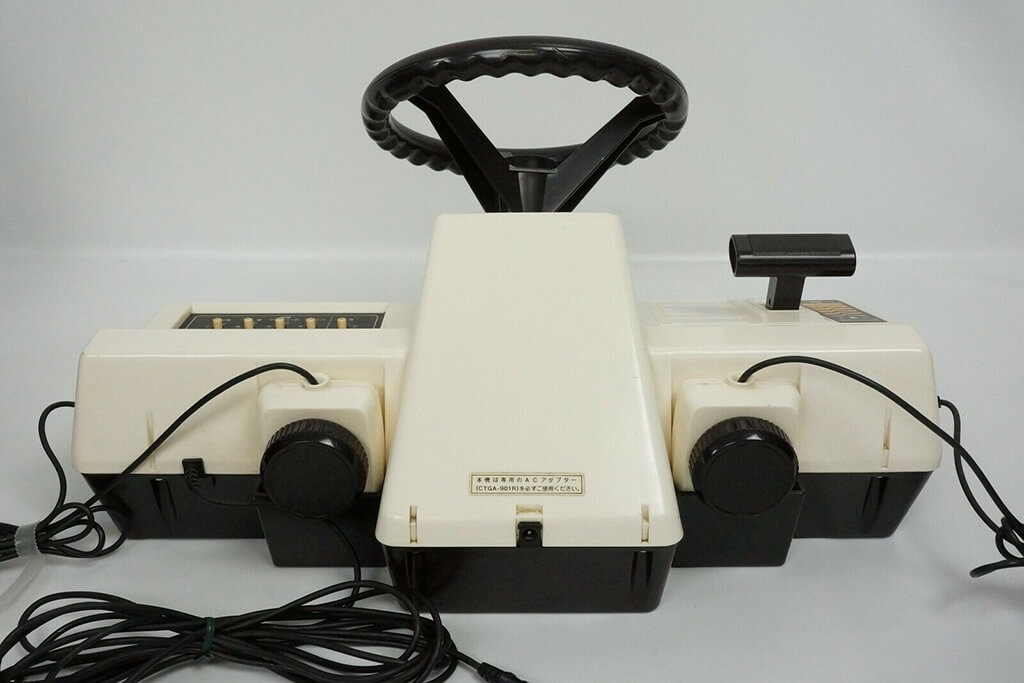
To play Nintendo’s car racing console, it was necessary to purchase separately the CTGA-901R external power adapter, which is suitable for the entire family of Color TV-Game consoles. This was a widespread practice by Nintendo which was repeated in other consoles and times such as the Famicom and Snes. If you already had the necessary pieces, why spend more money and space duplicating them?
Regarding the installation of the console, as was usual in those years, your father must have been an electrician or at least a full-fledged handyman. As televisions have a single antenna input, which theoretically forced them to choose between the console or the antenna (TV), the Nintendo console rightly included the classic adapter/switch to be able to connect both inputs. We talked about the years when we tuned the channels by hand, other times…
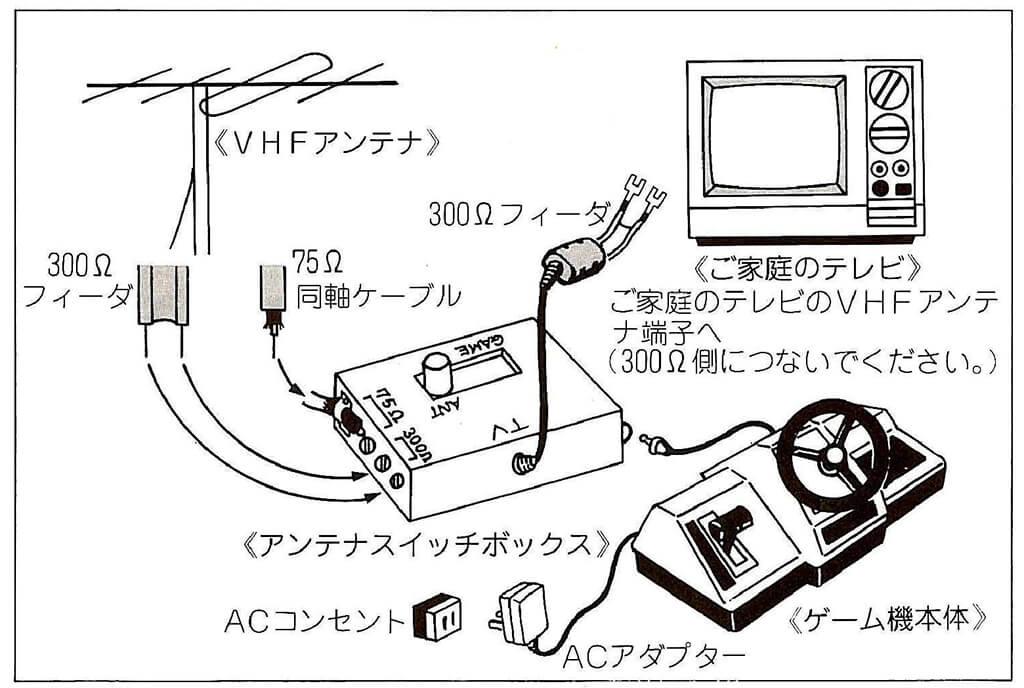
On the front of the machine is the control panel, which we will see in the next section since it mainly focuses on purely playable aspects. As a curiosity, the steering wheel of the console could be removed to facilitate transport and minimize the size of the packaging.
Regarding the internal architecture of the console, the Color TV-Game Racing 112 was a dedicated LSI console that lacked the CPU and graphics chips as we conceive it now. To simplify it, we can say that the very architecture and design of the board and integrated circuits defined the game itself, that is, the design of the circuitry is equivalent to programming. Therefore, in those years the engineers who designed the hardware were also designing the software. We can say that Masayuki Uemura’s team (engineer responsible for TV-Game) were true and innovative craftsmen of video games.
The 112 video games of the Nintendo Color TV-Game Racing 112
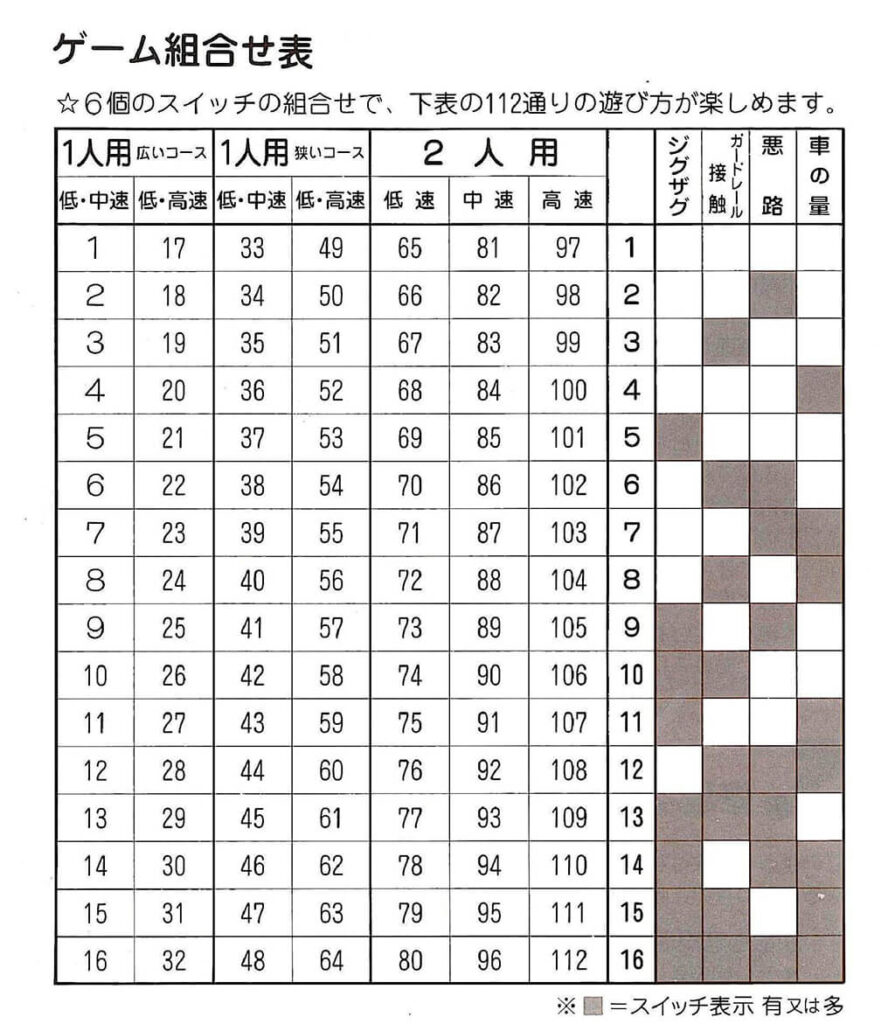
Did the Nintendo TV-Game Racing 112 have a staggering 112 games inside it? No, not really, what I did have was 1 racing game with 112 variants, as the image of the Japanese manual indicates. In practice, and as was the case with the Pong consoles of the time, each option or modification that the user had was considered a “game” by Nintendo in this case.
In this way, playing 1 or 2 players, on a wide or narrow track, with opponents moving in a straight line or zig zag, among other options, were considered different video games, as can be seen above. What do you not know Japanese? No problem, at Infoconsolas we translate it for you below so that it is better understood.
The 112 variants of the TV-Game Racing 112:
| 1 PLAYER WIDE COURT | 1 PLAYER NARROW COURT | 2 PLAYERS | …….. | Zig Zig Cars | Crash wall | Bad way | Number of cars | ||||
| Low – medium speed | Low speed – high | Speed low – medium | Low speed – high | Low speed | Average speed | High speed | |||||
| 1 | 17 | 33 | 49 | 65 | 81 | 97 | 1 | ||||
| 2 | 18 | 34 | 50 | 66 | 82 | 98 | 2 | OK | |||
| 3 | 19 | 35 | 51 | 67 | 83 | 99 | 3 | OK | |||
| 4 | 20 | 36 | 52 | 68 | 84 | 100 | 4 | OK | |||
| 5 | 21 | 37 | 53 | 69 | 85 | 101 | 5 | OK | |||
| 6 | 22 | 38 | 54 | 70 | 86 | 102 | 6 | OK | OK | ||
| 7 | 23 | 39 | 55 | 71 | 87 | 103 | 7 | OK | OK | ||
| 8 | 24 | 40 | 56 | 72 | 88 | 104 | 8 | OK | OK | ||
| 9 | 25 | 41 | 57 | 73 | 89 | 105 | 9 | OK | OK | ||
| 10 | 26 | 42 | 58 | 74 | 90 | 106 | 10 | OK | OK | ||
| 11 | 27 | 43 | 59 | 75 | 91 | 107 | 11 | OK | OK | ||
| 12 | 28 | 44 | 60 | 76 | 92 | 108 | 12 | OK | OK | OK | |
| 13 | 29 | 45 | 61 | 77 | 93 | 109 | 13 | OK | OK | OK | |
| 14 | 30 | 46 | 62 | 78 | 94 | 110 | 14 | OK | OK | OK | |
| 15 | 31 | 47 | 63 | 79 | 95 | 111 | 15 | OK | OK | OK | |
| 16 | 32 | 48 | 64 | 80 | 96 | 112 | 16 | OK | OK | OK | OK |
And how were all those options chosen? Well, with a good front panel full of switches as you can see in the image below, in which the switches of 1 player (wide or narrow track), 2 players, the 3 fixed speed options (low, medium and high ), the red start button (start), the on and off switch at the bottom left and then the four switches in which we will choose the zig zag of the cars, the collision with the wall, if there is a bad road and the high or low number of opponents. If you lower the 4 switches in a narrow path at high speed, you are true pro gamers of 1st generation of consoles.
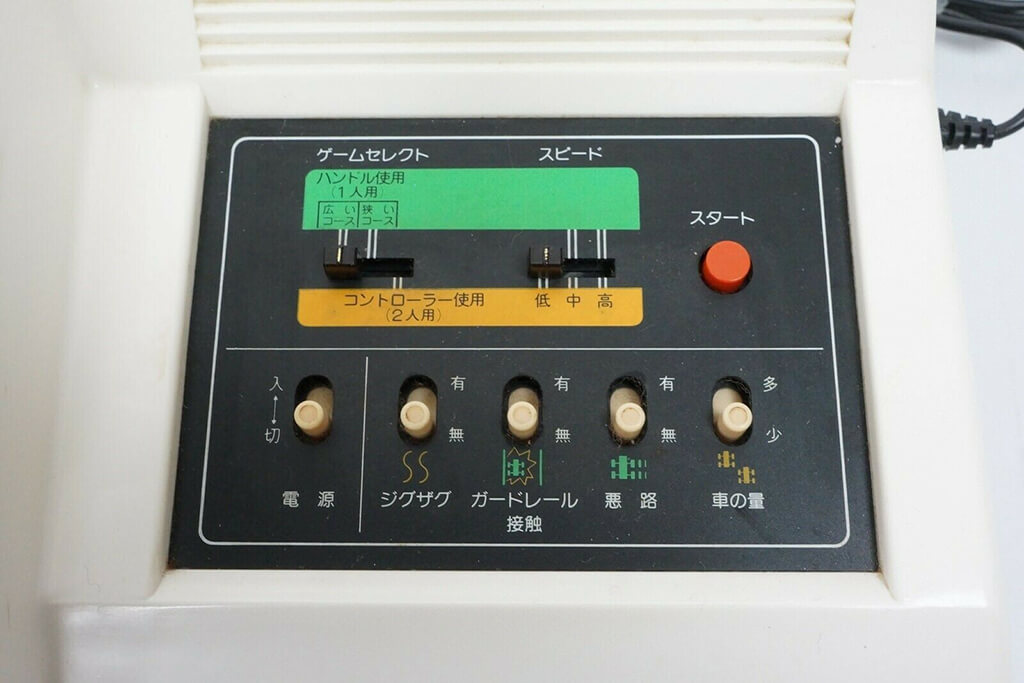
In the 1-player mode, you play with the steering wheel and you can choose between low-medium and low-high speeds with the gear lever, making it impossible to go low-low. In the 2-player mode, the path is always wide and the speed is constant, having to choose between low, medium or high, since in multiplayer it was played with the two wheel controls built into the console. In the following announcement you can see some of the aspects discussed.
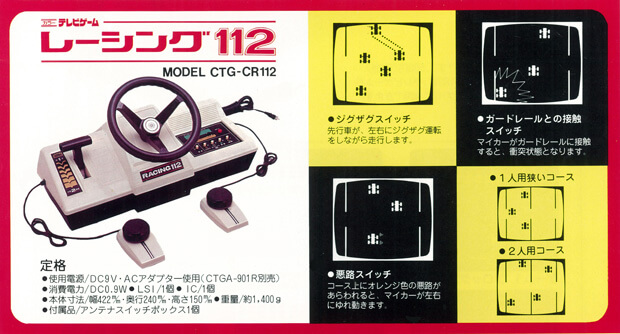
RETRO CURIOSITY X2! As with the Color TV-Game 6 and 15, the Nintendo logo does not appear anywhere visible on the console. This is due to the fact that in those years Nintendo was not a company with the current prestige nor was it closely linked to video games, so it was decided to launch and promote its own brand Color TV-Game, this being the most visible image in the first Nintendo consoles. On the other hand, they were consoles developed in collaboration with Mitsubishi Electric Corporation, making use of their technology, this being another possible reason for not linking them solely to Nintendo. The Game Boy Advance game WarioWare, Minigame Mania includes a racing minigame from TV-Game Racing 112 as a small tribute.
The gaming experience, is the Color TV-Game 112 currently playable?
No. It is not playable, no matter how much we regret it, no matter how many Nintendo fans we are, no matter how much we like retro and old video games, the answer is no. In case there is any doubt, I clarify it in the following fictitious dialogue:
- Young boys: David, David! Is Color TV-Game Racing 112 playable today? - Me: Nope. - Young boys: But if there are 112 games! Someone will have to... - Me: Nope. - Young boys: But if it is in color and it looks very fluid! - Me: Nope. - Young boys: But if they are from Nintendo! Pure history! - Me: Yep but nope to play. - Young boys: But a little while to play some doubles! - Me: A little yep. - Young boys: Aha! I caught you damned retrofogo infoconsolero!
Jokes aside, as with the first 2 Nintendo consoles, unless you are over 50 years old, have lived in Japan in the 70’s and have a lot of nostalgia in your veins, the third Nintendo console is not playable for the vast majority of players. It is normal even though it is a surprising and interesting machine, the mechanics of the 78′ can hardly engage more than 40 years later. What is the machine a hesitation? Absolutely, but its 112 race variants have not stood the test of time well.
Consequently, it is a shelf or display case console, beautiful to look at, wonderful to obtain and a great value for a console and video game collector, but it is not playable for more than 20 minutes for later generations.
The legacy of the Nintendo Racing 112
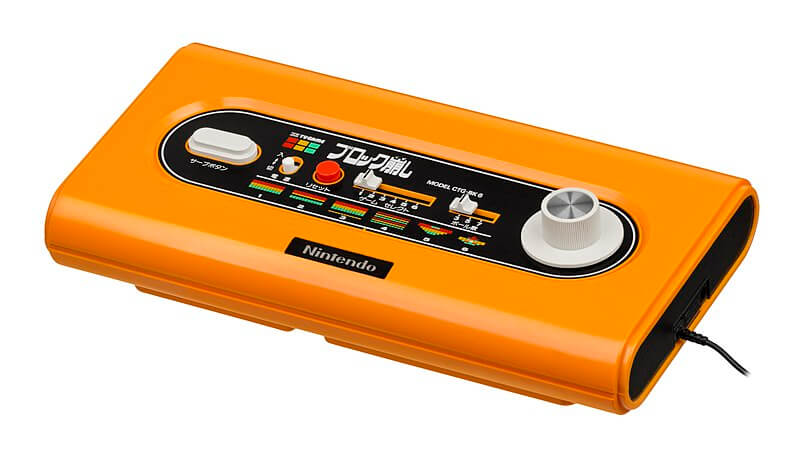
As we have already mentioned, the 112 belongs to the family of Nintendo Color TV-Game consoles, the series of machines with which Nintendo began its journey in Japanese homes. While Nintendo’s first two machines had been Pong-style and virtually all development had been Mitsubishi’s responsibility, with the Racing 112 Nintendo engineers were more actively involved, gaining experience and expertise that would become the foundation of the gaming industry. Japanese video games.
Just one year after Racing 112, Nintendo launched the Color TV Game Block Kuzushi console, based on the Atari Breakout, entirely developed by Nintendo engineers and with the exterior design by Shigeru Miyamoto, it was the pinnacle of LSI technology that they were using. Nintendo engineers were excited about this new industry and saw themselves capable of adapting all the successful genres of arcade machines to dedicated home consoles, designing dedicated consoles around the game, but all of this changed abruptly.
The reduction in prices and the arrival of new microprocessors in arcades and consoles, with the corresponding change in architecture and development that they entailed, brought the era of dedicated consoles to an end, initiating a true technological revolution in which cartridges, processors, memories, graphic chips and other elements. The new games that made use of the new microprocessors (acting as a CPU) with thousands of transistors inside, could no longer be recreated by Nintendo engineers with their knowledge and means, thus ending the series of Color TV-Game consoles. .
Fortunately, the seed was already sown, the experience enjoyed and the knowledge acquired. Nintendo’s market diversification had been successful and the home video game market had proven viable. After a huge miscalculation with its Computer TV Game console launched in 1980, Nintendo commissioned Ricoh to develop the chipset for what would be its next video game console, the Famicom or as we know it in the West, the Nintendo Entertainment System (NES) , the console that would save video games and take Nintendo to the top.
Consequently, the Color TV-Game Racing 112 retro console is part of the history of consoles and of Nintendo, and it is thanks to it and the rest of the Color TV-Game that Nintendo has become what it is today. They were some first steps already forgotten by many, but essential to start the path of success of the Japanese company, for many, the best video game console company of all time.
The price of the Nintendo Racing 112

At Infoconsolas we attach great importance to the price of the consoles that we analyze, in addition to their competition and context, in this way, we can put ourselves in a situation and discern, more than 40 years later, if a console was expensive or cheap for its time, even if it was marketed in a foreign currency such as the yen.
After all, the price of a console is one of the main factors that determine its success or failure in any society. Here you have the different launch prices of the most important consoles that coincided with the Nintendo Color TV-Game Racing 112.
| CONSOLE | LAUNCH | PRICE | BRAND |
| TV Tenis Electrotennis | 1975 | 19.500 yenes | Epoch |
| TV Game System 10 | 1977 | 15.500 yenes | Epoch |
| Color TV Game 6 | 1977 | 9.800 yenes | Nintendo |
| Color TV Game 15 | 1977 | 15.000 yenes | Nintendo |
| TV Jack 1000 | 1977 | 9.800 yenes | Bandai |
| TV Jack 5000 | 1978 | 19.800 yenes | Bandai |
| Fairchild Channel F | 1977 (1976 USA) | 128.000 yenes | Fairchild Semiconductor |
| Visicom C-100 | 1978 | 54.800 yenes | Toshiba |
| Color TV Game Racing 112 | 1978 | 18.000 yenes | Nintendo |
| TV Baseball | 1978 | 18.500 yenes | Epoch |
| Color TV Game Block Kuzushi | 1979 | 13.500 yenes | Nintendo |
| Super Vision 8000 | 1979 | 59.800 yenes | Bandai |
| Computer TV Game | 1980 | 48.000 yenes | Nintendo |
| Cassette Vision | 1981 | 13.500 yenes | Epoch |
As you can see, the Nintendo console was launched at a price consistent with that of its competitors in 1978, but the reality was that the Nintendo console was a failure unable to meet the high expectations that had been generated around it: The 112 games they were a single game with 112 variants, a disappointment. The public was bored with the Color TV-Game 112 and the console was disappointing on its own, so Nintendo opted to lower its price to 12,800 yen, a figure that continued to drop in subsequent months until the end of production and stock.
On the other hand, new second-generation consoles such as the Atari 2600 (1977) were launched in what was still the mecca of video games, the United States, presenting graphics far superior to the first generation of consoles and a colossal evolution: The cartridge. It is true that most of the consoles that were released on the North American market were not initially exported to Japan and that, since there was no Internet, the information that Japanese users had was minimal, so the influence on the Japanese market was initially almost non-existent, but some of those new machines like the 8-bit Fairchild Channel F were imported by Marubeni Housing Equipment Sales in 1977, at the same time that companies like Toshiba acquired the licenses for consoles like the RCA Studio II, improved the hardware and they launched them as their own second-generation consoles and cartridges (Visicom C-100 in 1978).
All these new second-generation consoles, which overlapped over time with Nintendo’s Color TV-Games, had lower sales due to their high prices, but they marked the path of the industry and showed consumers the evolution of home video games. , leaving the Color TV-Game Racing 112 practically obsolete since its launch.
In case anyone is wondering, even though the Atari 2600 was released in the West in 1977, it didn't make its debut in Japan until 1983, becoming known as the Atari 2800 and failing miserably against the mighty Famicom. If Atari had taken the step of releasing its console in 77' on the Japanese market, who knows how the history of video games would have developed...
One note before continuing! If you have come this far and before continuing, don’t forget to stop by Infoconsolas’ Twitter, you will find a thousand curiosities and much, much retro.
Collect the retro console Nintendo Color TV-Game Racing 112

Is the original Nintendo Color TV-Game Racing 112 worth collecting? Yes, of course, if you are a collector of retro consoles and video games, this console will be one of your main jewels along with the first Color TV-Game 6 and Color TV-Game 15. We are talking about the first consoles of the Big N, it is say, pure history of video games.
Now, unlike the previous consoles and most of the later Nintendo systems, the Racing 112 had little success, so getting one is going to be considerably more expensive than the TV-Game 6 and 15 or the Famicom itself. , only about 160,000 units were sold and that was more than 40 years ago… So there are fewer and fewer units in good condition.
Fortunately for those of us who are collectors of retro consoles and video games, the fact that it is a first-generation console exclusive to Japan eliminates the nostalgia factor of most collectors at a stroke, to which must be added the ignorance of so many players who mistakenly think that the Famicom/NES was Nintendo’s first console. This means that we can still find units in good condition at a reasonable price after 40 years, despite having had so little commercial success.
So yes, the Color TV-Game Racing 112 is a console that deserves to be on the shelves of all self-respecting retro collectors, being a very interesting piece due to the characteristics analyzed in this article and with one last point in its favor. From a collector’s point of view: Being exclusive to Japan there is a large percentage of very well preserved units, with its box and everything. These Japanese are picky eaters…
And if anyone is wondering… Yes, the Racing 112 will go up in price in the coming years for a few simple reasons:
- There are more and more retro collectors.
- There are fewer and fewer console units.
- The collectors who buy them don’t sell them.
- The Color TV-Games are becoming more and more popular.
- It will not be reissued in a mini version.
- It’s from Nintendo.
Buy an original Nintendo Color TV-Game Racing 112
Is it worth buying a TV-Game Racing 112? Yes, if you are a collector. Where to buy a Color TV-Game Racing 112? On eBay, for this type of console it is the best option unless you know someone in Japan who can do you the favor by buying it there directly. And the websites that act as intermediaries in Japan? My experience in several purchases has been disastrous, in the end I had to pay a series of expenses that in no case had been previously publicized in addition to customs, so I stick with eBay, which already includes customs expenses and has no surprises.
The following announcement will take you to a selection of TV-Game Racing 112 consoles where you can see the number of units currently available and the updated sale price.
Have you seen the prices? What do you think? As you will have seen, normally in the western market there are few units, and most of them come from Japanese sellers located in Japan, which is very positive except for the shipping and customs costs, but that is what retro console collecting has. . What am I going to tell you!
The price is the one that we have already mentioned before, from 150 euros without box and about 250 euros with box (2022), to which must be added the shipping costs, which in this case are considerable as it is a large console. (minimum 30 euros). As we always recommend at Infoconsolas, every good collector must have patience and know the market in which it operates, so don’t get too excited and plan your purchase of systems a little with a price table, so you’ll know for sure when you’re buying at a good price. price (forget about bargains that no longer exists).
And at this point, it’s time to consider a very interesting option when buying a Nintendo Color TV-Game Racing 112: Being a first-generation Japanese console, with all the handicaps that this entails (television, NTSC-J, scarce playability, voltage…), most likely once it reaches your home it will go straight to the shelf. Being realistic and aware of this, a great alternative is to buy a JUNK console, that is, a console that does not work or has not even been tested (it will not work). The reason? The price will be much, much, much cheaper and it will look just as good on your shelf, really.
If you are not going to play with the console, seriously consider this last option, you will have in your possession a system that is the history of video games and Nintendo, but at a much lower price.
STOP COLLECTOR! If you’ve seen the console listing on eBay, I want to say THANK YOU. Since 2004, the objective of Infoconsolas is to contribute to preserving the history of consoles and video games through our own collection of systems and the hours of work invested in this very website.
Being an eBay partner listing, if you buy a game or console, you will be helping Infoconsolas in the preservation of video game culture, so thank you very much again!
TOP: Best console games TV-Game Racing 112
Well, well, well… As the console has a single game with 112 variants, each one will have their tastes to decide if they prefer to run with a narrow path or opponents doing zig zag or not, so the best we can do in this section is to show you a good video from the Angel Retromanos channel, in which you will see an unboxing of the console and how it worked.
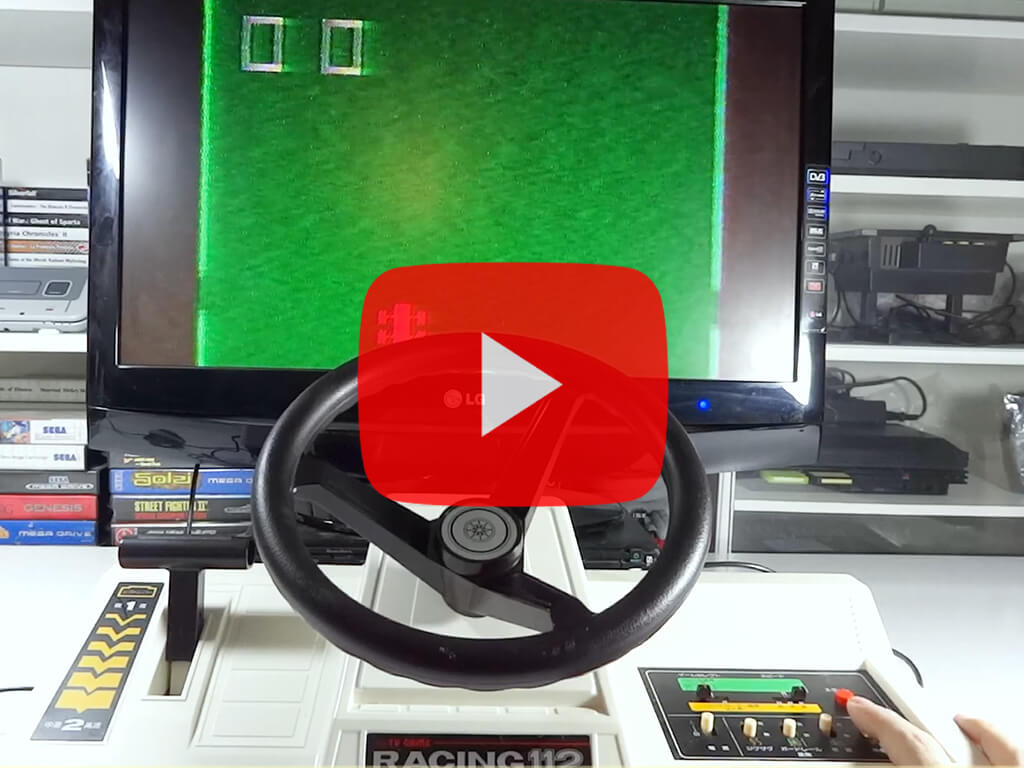
FAQ Nintendo Color TV-Game Racing 112
Here you have the most frequent curiosities, questions and answers of the Nintendo Color TV-Game Racing 112 retro consoles, little by little we will expand this section:
On June 24, 1978 in Japan.
It is a first generation retro console.
No, es exclusiva de Japón.
Approximately 160,000 units
You can find a unit without a box from 150 euros and with a box from 200 euros plus shipping costs (Jan. 2022).
Yes, it came out 5 years earlier.
Yes, it was a cheap console for what it offered in the Japanese market.
Those that came integrated, 112 variants.
Integrated games.
No. Only Nintendo manufactured and marketed the console.
No, a power adapter was required.
No, they were all racing.
To control your car in its 112 racing games (variants), only in 1 player mode.
1 or 2 players.
External sources and links
- Graphic resources:
https://www.nintendo.co.jp/n10/interview/game_and_watch/vol1/index.html


